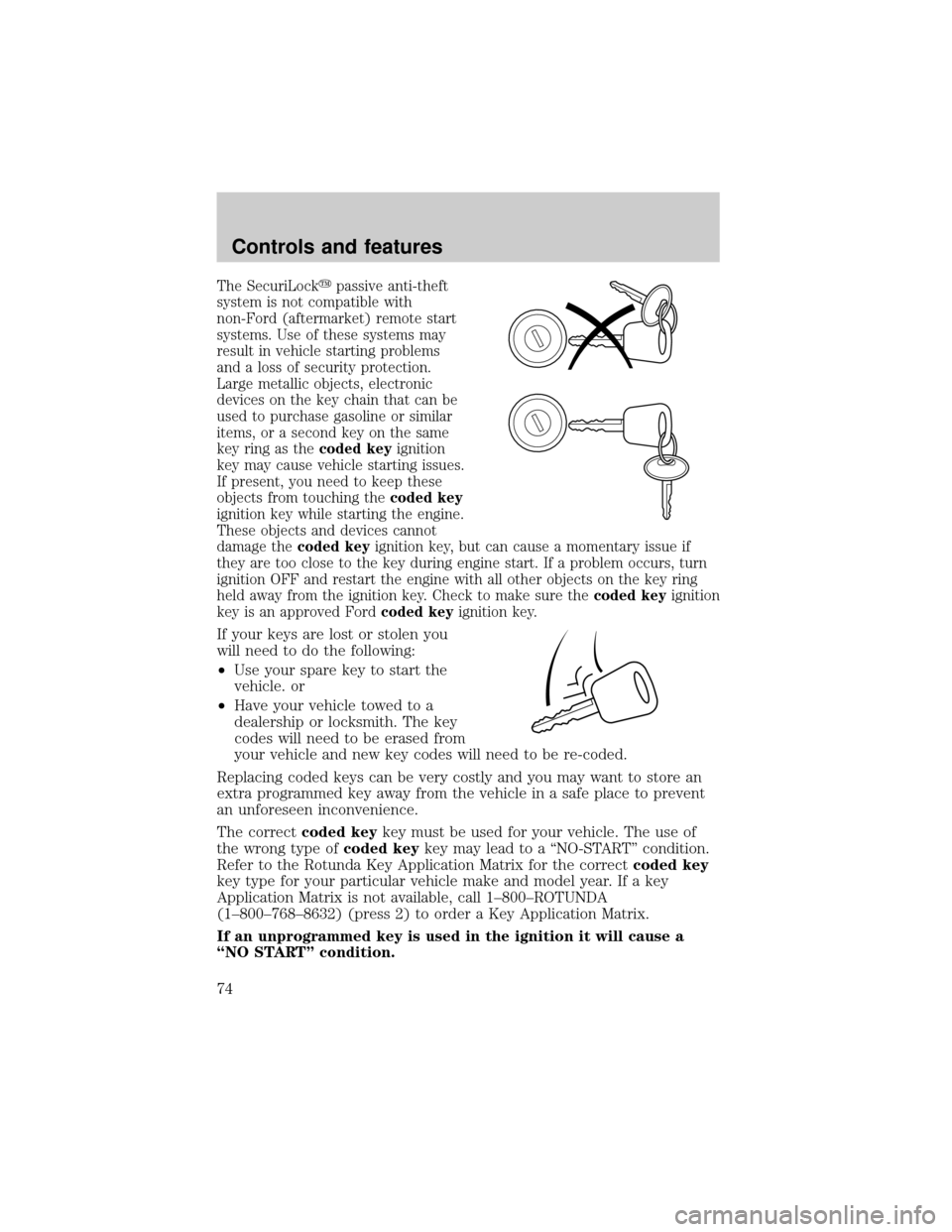remote control Mercury Sable 2001 s User Guide
[x] Cancel search | Manufacturer: MERCURY, Model Year: 2001, Model line: Sable, Model: Mercury Sable 2001Pages: 240, PDF Size: 2.22 MB
Page 74 of 240

The SecuriLockypassive anti-theft
system is not compatible with
non-Ford (aftermarket) remote start
systems. Use of these systems may
result in vehicle starting problems
and a loss of security protection.
Large metallic objects, electronic
devices on the key chain that can be
used to purchase gasoline or similar
items, or a second key on the same
key ring as thecoded keyignition
key may cause vehicle starting issues.
If present, you need to keep these
objects from touching thecoded key
ignition key while starting the engine.
These objects and devices cannot
damage thecoded keyignition key, but can cause a momentary issue if
they are too close to the key during engine start. If a problem occurs, turn
ignition OFF and restart the engine with all other objects on the key ring
held away from the ignition key. Check to make sure thecoded keyignition
key is an approved Fordcoded keyignition key.
If your keys are lost or stolen you
will need to do the following:
²Use your spare key to start the
vehicle. or
²Have your vehicle towed to a
dealership or locksmith. The key
codes will need to be erased from
your vehicle and new key codes will need to be re-coded.
Replacing coded keys can be very costly and you may want to store an
extra programmed key away from the vehicle in a safe place to prevent
an unforeseen inconvenience.
The correctcoded keykey must be used for your vehicle. The use of
the wrong type ofcoded keykey may lead to a ªNO-STARTº condition.
Refer to the Rotunda Key Application Matrix for the correctcoded key
key type for your particular vehicle make and model year. If a key
Application Matrix is not available, call 1±800±ROTUNDA
(1±800±768±8632) (press 2) to order a Key Application Matrix.
If an unprogrammed key is used in the ignition it will cause a
ªNO STARTº condition.
Controls and features
74
Page 81 of 240

3. Lift the remote latch release on
the left side of the compartment
and fold the remaining floor panel
until it latches. Make sure the
seatback is locked in the upright
position.
To close the seat, make sure the safety belts are properly stowed, then
lift the remote latch release and push the seat down until it latches. Pull
up on the handle and push the floor panel into place.
SAFETY RESTRAINTS
Personal Safety System
The Personal Safety System provides an improved overall level of frontal
crash protection to front seat occupants and is designed to help further
reduce the risk of air bag-related injuries. The system is able to analyze
different occupant conditions and crash severity before activating the
appropriate safety devices to help better protect a range of occupants in
a variety of frontal crash situations.
Your vehicle's Personal Safety System consists of:
²Driver and passenger dual-stage air bag supplemental restraints. Refer
to theAir bag supplemental restraintssection in this chapter.
²Front safety belts with pretensioners, energy management retractors,
and safety belt usage sensors. Refer to theSafety beltssection in this
chapter.
²Driver's seat position sensor.
²Front crash severity sensor.
²Restraints Control Module (RCM) with impact and safing sensors.
²An indicator light and back-up tone.
²The electrical wiring for the air bags, crash sensor(s), safety belt
pretensioners, front safety belt usage sensors and driver's seat position
sensor.
Seating and safety restraints
81
Page 236 of 240

child safety seats ....................105
cleaning ...........................208±209
SecuriLock passive
anti-theft system ...................73, 75
Servicing your vehicle ..............153
Spark plugs,
specifications .....................210, 213
Specification chart,
lubricants ...........................212±213
Speed control ..............................47
Speedometer ...............................14
Starting your vehicle ........113, 115
jump starting ..........................147
Steering wheel
tilting .........................................52
T
Tachometer .................................14
Tires ...........................143, 178±180
changing ..........................143±144
checking the pressure ............180
replacing ..................................181
rotating ....................................180
snow tires and chains ............181
tire grades ...............................179
treadwear ................................179
Towing .......................................130
recreational towing .................133
trailer towing ..........................130
wrecker ....................................152
Traction control ..................46, 121
active light ..................................8
Transaxle
automatic operation ...............123
fluid, refill capacities ..............211lubricant specifications ..........213
Transmission
fluid, checking and adding
(automatic) .............................168
lubricant specifications ..........212
Trip odometer .............................15
Trunk .........................61, 63±64, 76
remote release ..........................60
Turn signal ..............................8, 50
V
Vehicle dimensions ...................213
Vehicle Identification
Number (VIN) ...........................216
Vehicle loading ..........................128
Ventilating your vehicle ...........117
W
Warning chimes ...........................13
Warning lights (see Lights) .........8
Washer fluid ..............................161
Water, Driving through .............129
Windows
power .........................................56
rear wiper/washer .....................51
Windshield washer fluid and
wipers
checking and adding fluid .....161
checking and cleaning ....177±178
liftgate reservoir .....................162
operation ...................................50
replacing wiper blades ...........178
Wrecker towing .........................152
Index
236